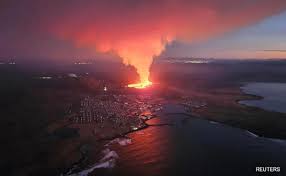In a dramatic display of nature’s power, a volcano in southwestern Iceland erupted for the fifth time since December, sending red-hot lava cascading towards the coastal town of Grindavik and leading to the evacuation of the renowned Blue Lagoon geothermal spa. This latest eruption, which began on Wednesday afternoon, follows a series of earthquakes and showcases the volatile geological activity of the region.
The Eruption Unfolds
Initial Signs and Earthquakes
The volcanic activity was preceded by a series of earthquakes north of Grindavik, a town with a population of 3,800. These tremors served as a precursor to the eruption, causing concern among residents and authorities.
Eruption Details
The eruption began in the early afternoon, spewing lava up to 50 meters (165 feet) into the sky. A fissure stretching 3.5 kilometers (2.1 miles) in length opened, releasing a river of molten rock. The Icelandic Meteorological Office reported that this eruption was the most vigorous in the area since the volcano reawakened in December.
Impact on Grindavik
Evacuation Efforts
As lava flowed towards Grindavik, the town faced imminent danger. Two of the three roads leading to the town were cut off, prompting evacuation measures. The local authorities prioritized the safety of the residents, ensuring that everyone was moved to secure locations.
Protective Barriers
Barriers built to protect Grindavik played a crucial role in deflecting the lava flow. These structures prevented the molten rock from engulfing the town entirely, although the situation remained precarious with lava nearing the third road into Grindavik.
The Blue Lagoon’s Evacuation
A Major Tourist Attraction
The Blue Lagoon geothermal spa, a major tourist attraction, also faced the threat of the encroaching lava. Known for its milky blue waters and healing properties, the spa draws visitors from around the world.
Evacuation Procedures
In response to the eruption, authorities evacuated the Blue Lagoon to ensure the safety of visitors and staff. The evacuation was carried out smoothly, demonstrating the effectiveness of the emergency protocols in place.
Volcanic Activity and Geological Significance
Iceland’s Volcanic History
Iceland is renowned for its volcanic activity, with numerous eruptions shaping its landscape over centuries. The country sits on the Mid-Atlantic Ridge, where the Eurasian and North American tectonic plates meet, resulting in frequent seismic and volcanic activity.
Recent Eruptions
The current eruption is the fifth since December, marking an active period for the region. Previous eruptions have also posed threats to nearby communities, highlighting the need for constant vigilance and preparedness.
Scientific Observations
Monitoring the Eruption
Scientists from the Icelandic Meteorological Office and other institutions have been closely monitoring the eruption. Their observations provide critical data on the eruption’s intensity, lava flow, and potential impact on surrounding areas.
Geological Studies
This eruption offers a unique opportunity for geological studies. Researchers are keen to understand the underlying causes of the increased volcanic activity and to predict future eruptions more accurately.
Environmental Impact
Lava Flow and Landscape Changes
The flowing lava has the potential to alter the landscape significantly. It can destroy vegetation, reshape landforms, and create new geological features. The long-term environmental impact will depend on the eruption’s duration and intensity.
Air Quality Concerns
Volcanic eruptions release gases such as sulfur dioxide, which can affect air quality. Monitoring air quality is essential to ensure the safety of residents and visitors in the affected areas.
Emergency Response and Preparedness
Local Authorities’ Role
Local authorities have played a vital role in managing the crisis. Their quick response and effective communication have been crucial in minimizing the eruption’s impact on the population.
Evacuation Plans
Evacuation plans are a critical component of emergency preparedness. The recent evacuation of Grindavik and the Blue Lagoon demonstrates the importance of having well-defined procedures in place.
Economic Implications
Impact on Tourism
The eruption has significant implications for Iceland’s tourism industry. The Blue Lagoon is a major tourist attraction, and its closure will affect local businesses that rely on tourist spending.
Recovery and Rebuilding
Post-eruption recovery will involve rebuilding infrastructure and supporting affected communities. The economic impact will depend on the duration of the eruption and the extent of the damage.
The recent volcanic eruption in southwestern Iceland serves as a stark reminder of the powerful geological forces at play. As Grindavik and the Blue Lagoon face the immediate threat of flowing lava, the resilience and preparedness of local authorities and communities are put to the test. The scientific community continues to monitor the situation, providing valuable insights into the eruption’s progression and potential future activity.




